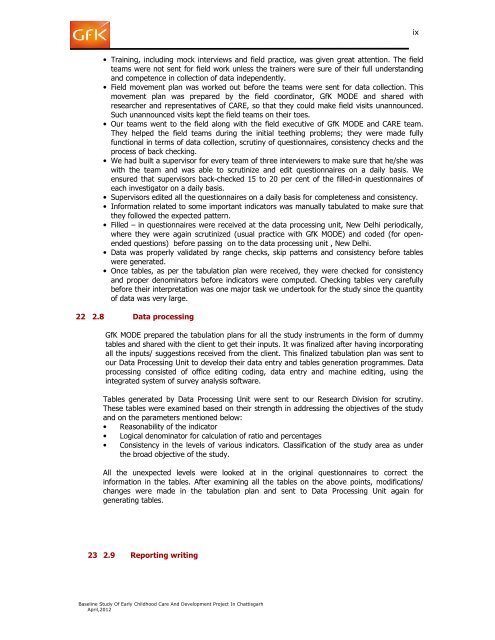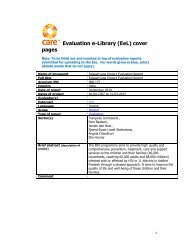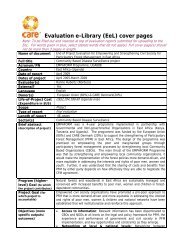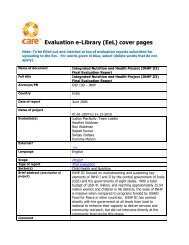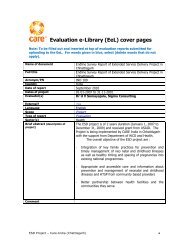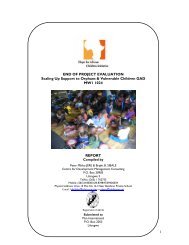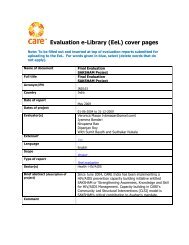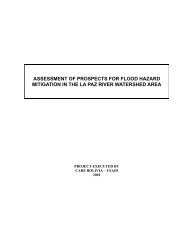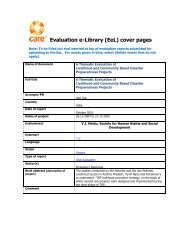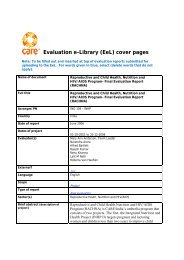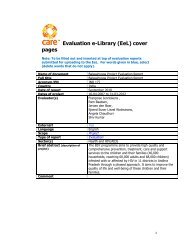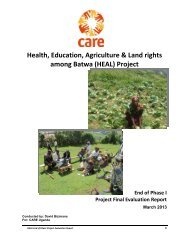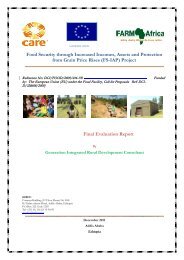IND 199 ECDE Baseline - CARE International's Electronic ...
IND 199 ECDE Baseline - CARE International's Electronic ...
IND 199 ECDE Baseline - CARE International's Electronic ...
- No tags were found...
You also want an ePaper? Increase the reach of your titles
YUMPU automatically turns print PDFs into web optimized ePapers that Google loves.
ix• Training, including mock interviews and field practice, was given great attention. The fieldteams were not sent for field work unless the trainers were sure of their full understandingand competence in collection of data independently.• Field movement plan was worked out before the teams were sent for data collection. Thismovement plan was prepared by the field coordinator, GfK MODE and shared withresearcher and representatives of <strong>CARE</strong>, so that they could make field visits unannounced.Such unannounced visits kept the field teams on their toes.• Our teams went to the field along with the field executive of GfK MODE and <strong>CARE</strong> team.They helped the field teams during the initial teething problems; they were made fullyfunctional in terms of data collection, scrutiny of questionnaires, consistency checks and theprocess of back checking.• We had built a supervisor for every team of three interviewers to make sure that he/she waswith the team and was able to scrutinize and edit questionnaires on a daily basis. Weensured that supervisors back-checked 15 to 20 per cent of the filled-in questionnaires ofeach investigator on a daily basis.• Supervisors edited all the questionnaires on a daily basis for completeness and consistency.• Information related to some important indicators was manually tabulated to make sure thatthey followed the expected pattern.• Filled – in questionnaires were received at the data processing unit, New Delhi periodically,where they were again scrutinized (usual practice with GfK MODE) and coded (for openendedquestions) before passing on to the data processing unit , New Delhi.• Data was properly validated by range checks, skip patterns and consistency before tableswere generated.• Once tables, as per the tabulation plan were received, they were checked for consistencyand proper denominators before indicators were computed. Checking tables very carefullybefore their interpretation was one major task we undertook for the study since the quantityof data was very large.22 2.8 Data processingGfK MODE prepared the tabulation plans for all the study instruments in the form of dummytables and shared with the client to get their inputs. It was finalized after having incorporatingall the inputs/ suggestions received from the client. This finalized tabulation plan was sent toour Data Processing Unit to develop their data entry and tables generation programmes. Dataprocessing consisted of office editing coding, data entry and machine editing, using theintegrated system of survey analysis software.Tables generated by Data Processing Unit were sent to our Research Division for scrutiny.These tables were examined based on their strength in addressing the objectives of the studyand on the parameters mentioned below:• Reasonability of the indicator• Logical denominator for calculation of ratio and percentages• Consistency in the levels of various indicators. Classification of the study area as underthe broad objective of the study.All the unexpected levels were looked at in the original questionnaires to correct theinformation in the tables. After examining all the tables on the above points, modifications/changes were made in the tabulation plan and sent to Data Processing Unit again forgenerating tables.23 2.9 Reporting writing<strong>Baseline</strong> Study Of Early Childhood Care And Development Project In ChattisgarhApril,2012


